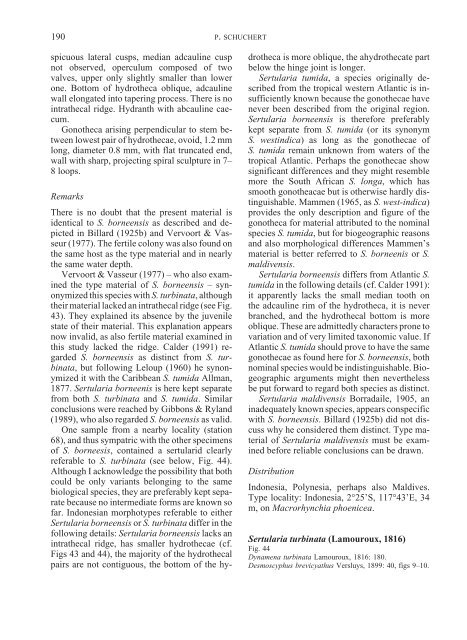Hydroids (Cnidaria, Hydrozoa) of the Danish expedition to
Hydroids (Cnidaria, Hydrozoa) of the Danish expedition to
Hydroids (Cnidaria, Hydrozoa) of the Danish expedition to
You also want an ePaper? Increase the reach of your titles
YUMPU automatically turns print PDFs into web optimized ePapers that Google loves.
190<br />
spicuous lateral cusps, median adcauline cusp<br />
not observed, operculum composed <strong>of</strong> two<br />
valves, upper only slightly smaller than lower<br />
one. Bot<strong>to</strong>m <strong>of</strong> hydro<strong>the</strong>ca oblique, adcauline<br />
wall elongated in<strong>to</strong> tapering process. There is no<br />
intra<strong>the</strong>cal ridge. Hydranth with abcauline caecum.<br />
Gono<strong>the</strong>ca arising perpendicular <strong>to</strong> stem between<br />
lowest pair <strong>of</strong> hydro<strong>the</strong>cae, ovoid, 1.2 mm<br />
long, diameter 0.8 mm, with flat truncated end,<br />
wall with sharp, projecting spiral sculpture in 7–<br />
8 loops.<br />
Remarks<br />
There is no doubt that <strong>the</strong> present material is<br />
identical <strong>to</strong> S. borneensis as described and depicted<br />
in Billard (1925b) and Vervoort & Vasseur<br />
(1977). The fertile colony was also found on<br />
<strong>the</strong> same host as <strong>the</strong> type material and in nearly<br />
<strong>the</strong> same water depth.<br />
Vervoort & Vasseur (1977) – who also examined<br />
<strong>the</strong> type material <strong>of</strong> S. borneensis – synonymized<br />
this species with S. turbinata, although<br />
<strong>the</strong>ir material lacked an intra<strong>the</strong>cal ridge (see Fig.<br />
43). They explained its absence by <strong>the</strong> juvenile<br />
state <strong>of</strong> <strong>the</strong>ir material. This explanation appears<br />
now invalid, as also fertile material examined in<br />
this study lacked <strong>the</strong> ridge. Calder (1991) regarded<br />
S. borneensis as distinct from S. turbinata,<br />
but following Leloup (1960) he synonymized<br />
it with <strong>the</strong> Caribbean S. tumida Allman,<br />
1877. Sertularia borneenis is here kept separate<br />
from both S. turbinata and S. tumida. Similar<br />
conclusions were reached by Gibbons & Ryland<br />
(1989), who also regarded S. borneensis as valid.<br />
One sample from a nearby locality (station<br />
68), and thus sympatric with <strong>the</strong> o<strong>the</strong>r specimens<br />
<strong>of</strong> S. borneesis, contained a sertularid clearly<br />
referable <strong>to</strong> S. turbinata (see below, Fig. 44).<br />
Although I acknowledge <strong>the</strong> possibility that both<br />
could be only variants belonging <strong>to</strong> <strong>the</strong> same<br />
biological species, <strong>the</strong>y are preferably kept separate<br />
because no intermediate forms are known so<br />
far. Indonesian morphotypes referable <strong>to</strong> ei<strong>the</strong>r<br />
Sertularia borneensis or S. turbinata differ in <strong>the</strong><br />
following details: Sertularia borneensis lacks an<br />
intra<strong>the</strong>cal ridge, has smaller hydro<strong>the</strong>cae (cf.<br />
Figs 43 and 44), <strong>the</strong> majority <strong>of</strong> <strong>the</strong> hydro<strong>the</strong>cal<br />
pairs are not contiguous, <strong>the</strong> bot<strong>to</strong>m <strong>of</strong> <strong>the</strong> hy-<br />
P. SCHUCHERT<br />
dro<strong>the</strong>ca is more oblique, <strong>the</strong> ahydro<strong>the</strong>cate part<br />
below <strong>the</strong> hinge joint is longer.<br />
Sertularia tumida, a species originally described<br />
from <strong>the</strong> tropical western Atlantic is insufficiently<br />
known because <strong>the</strong> gono<strong>the</strong>cae have<br />
never been described from <strong>the</strong> original region.<br />
Sertularia borneensis is <strong>the</strong>refore preferably<br />
kept separate from S. tumida (or its synonym<br />
S. westindica) as long as <strong>the</strong> gono<strong>the</strong>cae <strong>of</strong><br />
S. tumida remain unknown from waters <strong>of</strong> <strong>the</strong><br />
tropical Atlantic. Perhaps <strong>the</strong> gono<strong>the</strong>cae show<br />
significant differences and <strong>the</strong>y might resemble<br />
more <strong>the</strong> South African S. longa, which has<br />
smooth gono<strong>the</strong>acae but is o<strong>the</strong>rwise hardly distinguishable.<br />
Mammen (1965, as S. west-indica)<br />
provides <strong>the</strong> only description and figure <strong>of</strong> <strong>the</strong><br />
gono<strong>the</strong>ca for material attributed <strong>to</strong> <strong>the</strong> nominal<br />
species S. tumida, but for biogeographic reasons<br />
and also morphological differences Mammen’s<br />
material is better referred <strong>to</strong> S. borneenis or S.<br />
maldivensis.<br />
Sertularia borneensis differs from Atlantic S.<br />
tumida in <strong>the</strong> following details (cf. Calder 1991):<br />
it apparently lacks <strong>the</strong> small median <strong>to</strong>oth on<br />
<strong>the</strong> adcauline rim <strong>of</strong> <strong>the</strong> hydro<strong>the</strong>ca, it is never<br />
branched, and <strong>the</strong> hydro<strong>the</strong>cal bot<strong>to</strong>m is more<br />
oblique. These are admittedly characters prone <strong>to</strong><br />
variation and <strong>of</strong> very limited taxonomic value. If<br />
Atlantic S. tumida should prove <strong>to</strong> have <strong>the</strong> same<br />
gono<strong>the</strong>cae as found here for S. borneensis, both<br />
nominal species would be indistinguishable. Biogeographic<br />
arguments might <strong>the</strong>n never<strong>the</strong>less<br />
be put forward <strong>to</strong> regard both species as distinct.<br />
Sertularia maldivensis Borradaile, 1905, an<br />
inadequately known species, appears conspecific<br />
with S. borneensis. Billard (1925b) did not discuss<br />
why he considered <strong>the</strong>m distinct. Type material<br />
<strong>of</strong> Sertularia maldivensis must be examined<br />
before reliable conclusions can be drawn.<br />
Distribution<br />
Indonesia, Polynesia, perhaps also Maldives.<br />
Type locality: Indonesia, 2°25’S, 117°43’E, 34<br />
m, on Macrorhynchia phoenicea.<br />
Sertularia turbinata (Lamouroux, 1816)<br />
Fig. 44<br />
Dynamena turbinata Lamouroux, 1816: 180.<br />
Desmoscyphus brevicyathus Versluys, 1899: 40, figs 9–10.

















